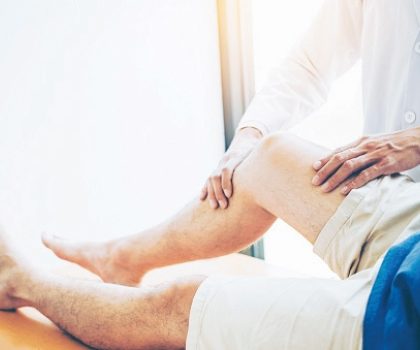Avoid surgery by trying physical therapy first

By Dr. Adam Cramer, PT, DPT; MyoFit Clinic
The knee is one of the most-used joints in the body. It’s designed to handle the repetitive stress of day-to-day use. But being pushed beyond its limits or turned in a direction it’s not meant to can cause pain and injury. When this happens, physical therapy is the best option for treatment.
For many, the first step following a knee injury is to consult with a surgeon. Yet these professionals’ specialty is surgery. Independent physical therapists focus on cost-effective, low-risk physical therapy treatment and not higher-cost, higher-risk surgical procedures. No referral is needed for physical therapy in the state of Ohio.
MRIs and X-rays are not needed to diagnose knee injuries—especially when we all have abnormalities within our joints and imaging can produce false positives. And injections don’t properly address the lack of motion and strength that an individual with knee pain has. Based on evidence, steroid injections can actually deteriorate tendons, promote cartilage loss and create bone fractures under the cartilage.
All of these invasive procedures do nothing to correct the underlying problem, they’re just treating the symptoms. The underlying problem with most joint pain is lack of motion and strength. If you work at improving how well you move, you will move better. Cartilage in joints is like a sponge. When it is used it will soak up all the nutrients around it while getting rid of waste products in the joint that can degenerate cartilage. Movement is the key. By focusing on the structures that make us move, such as muscles, you will undoubtedly move better with fewer symptoms.
When the knee is stressed through exercise, it promotes strength, increases blood flow, improves oxygenation and ultimately leads to healing.
Physical therapy treatment for knee pain will include hands-on treatment to promote blood flow, healing and range of motion. Dry needling will help reduce pain while promoting healing and muscle contraction. Therapeutic exercise promotes strengthening and stabilization of the knee joint to reduce excessive shearing/rotational forces that can lead to further damage of the joint.
When you visit MyoFit, you will have a thorough understanding of how to maintain and treat your symptoms independently and reach your goals.
Dr. Adam M. Cramer, PT, DPT, is a licensed physical therapist and the owner of MyoFit Clinics. For more information, visit MyoFitClinic.com. Clinics are located in Middlefield, 440-632-1007, Chardon, 440-286-1007, and Ashtabula 440-993-1004.
